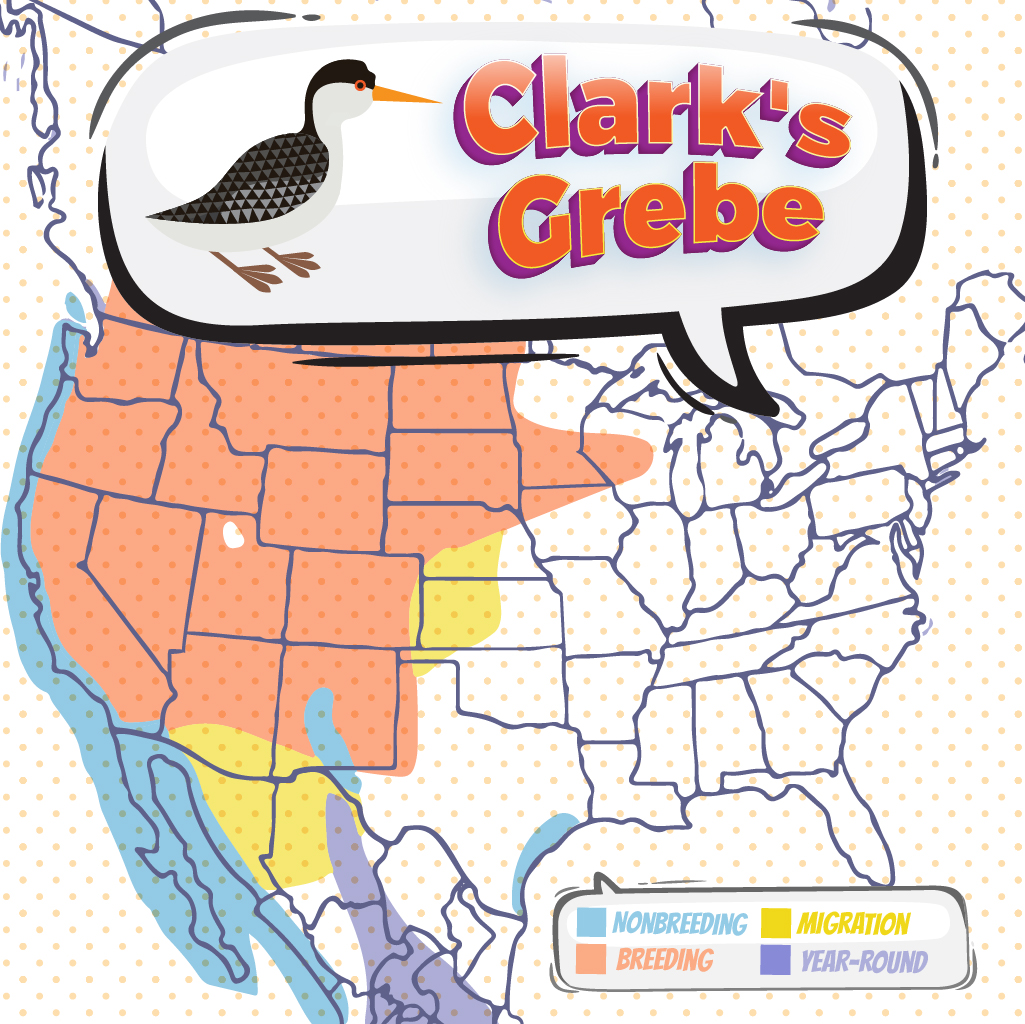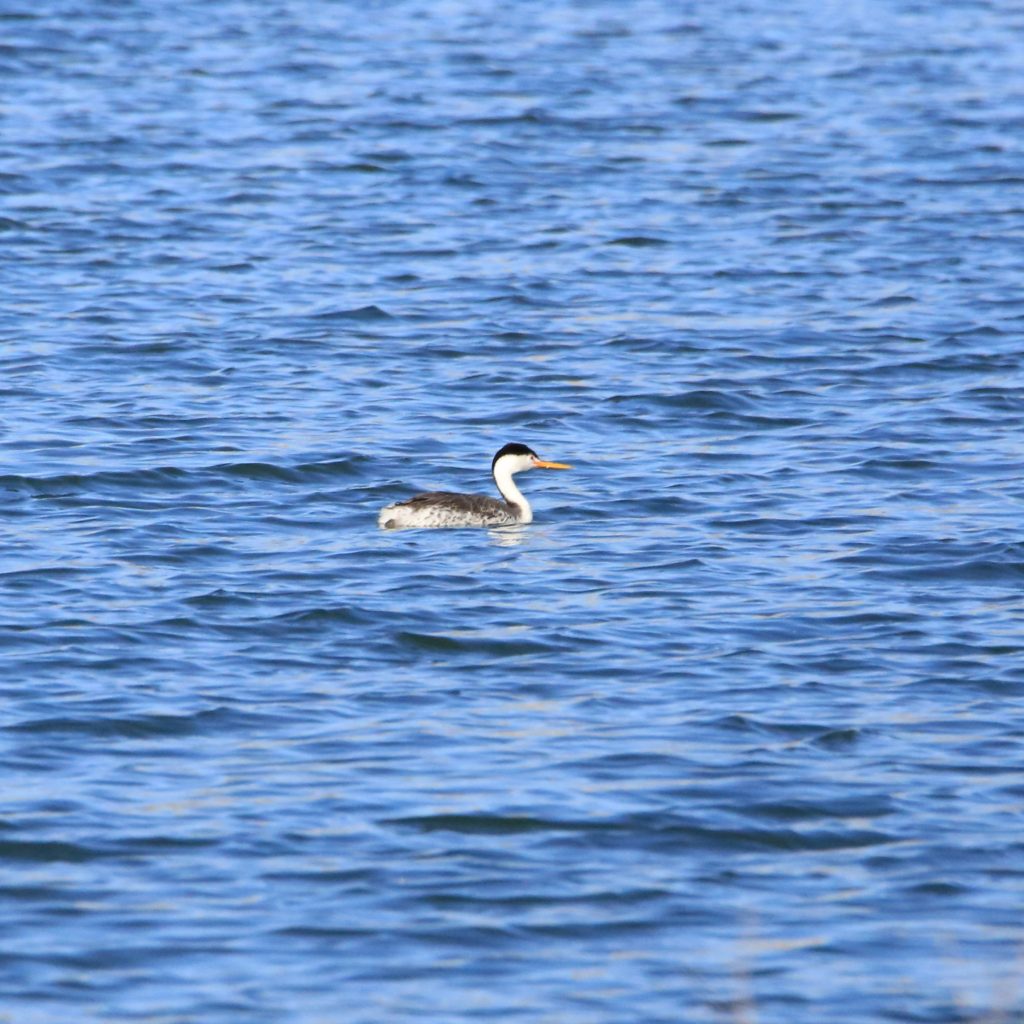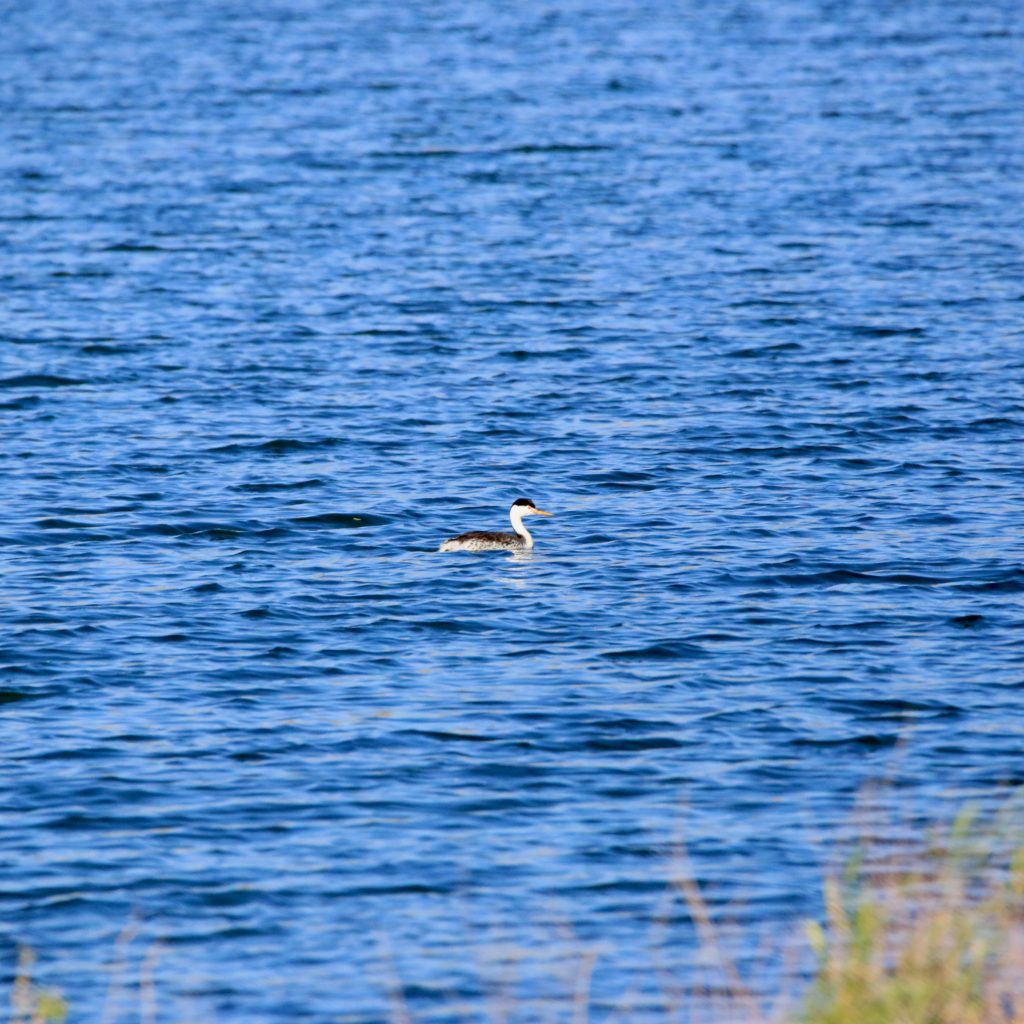
Clark’s Grebe
A Clark’s Grebe is a fun bird to see while bird watching. Below are some tips to help you identify Clark’s Grebes. We have also put together a list of fun Clark’s Grebe t-shirts, Clark’s Grebe bird patches, bird houses, bird feeders, binoculars, stickers and other fun bird watching items.
About Clark’s Grebes
These grebes can be mistaken for their relatives, the western grebes. In fact, they were dismissed as a western grebe’s variant, but it was not until the 1980s when research showed that they were two different species. Their distinctive bills, voice and face pattern forms the bulk of the difference. Some of their distinctive features include:
Description and Identification
Clarks Grebe’s are often mistaken for Western Grebes due to their similar appearance and the fact that several times the two species share the same habitat. Clarks Grebes have a long and slender body, possessing a long and thin yellow beak. They sport dark gray-black plumage on their upper parts accompanied with white plumage on their lower parts. The inner neck is colored white whereas the back of their necks shares the same color as their upperparts. Their black plumage ends right above their sharp red eyes, making the eyes stand out. The sexes are similar in appearance, with the exception of the males sporting slight crests on their heads. Adult Clarks Grebe’s grow to be 22-29 inches in length and weigh between 25.3-44.4oz.
Clark’s Grebe Color Pattern
These large grebes have white underparts and gray-black upper parts. Their slightly long neck is black at the back and white in front. Their white face consists of a black cap that extends down to the eyes and their bill is yellow-orange.
Clark’s Grebe Size
They are medium-sized birds that almost resemble the crown in size. They have a long neck and a long, thin bill.
The relative sizes of both sexes
- Length range: 21.6-29.5 in (55-75 cm)
- Weight: 25.3-59.4 oz (718-1685 g)
- Wingspan range: 31.9-32.3 in (81-82 cm)
Clark’s Grebe Behavior
They forage by diving underwater searching for prey. Their calls are somewhat similar to the western grebes’ calls. However, their call is singular as opposed to the western grebes’ which is a two-note. Males tend to have several sexual partners and will leave the current partner shortly after the breeding season.
Clark’s Grebe Food
Their diets mainly consist of non-vegetarian material; feeding primarily on small and medium
sized fish found in their habitat of preference. They typically hunt fishes and insects swimming
close to the surface of the water by jabbing the prey using their beaks as spears or secure it
between its mandibles. Occasionally hunting is carried out at the bottom of the water bodies as
well. Other preys of choice of Clarks Grebe’s include salamanders, aquatic insects,
crustaceans, grasshoppers, marine worms, etc.
The diet is mainly made up of fish. However, they are opportunistic grebes that feed on anything that is available. Therefore, they can feed on a variety of aquatic creatures such as aquatic insects, polychaete worms, salamanders and crustaceans.
Clark’s Grebe Habitat
The natural habitats of Clarks Grebe’s include open oceans and saltwater bays along with
occurrences in lakes as well. During the nesting season they prefer to inhabit freshwater lakes
streams, and marshes surrounded by vegetation. After the nesting season ends, they move to
lakes where they become flightless due to the molting of their wing feathers. Once new wing
feathers grow, they migrate to saltwater habitats.
Clark’s grebes are widespread from south Mexico to British Colombia. They prefer water bodies that are plenty with food and in close proximity to tree cover. They usually use the cover for nesting. Breeding takes place in the large part of North America and prefers to winter in Central America and south towards Mexico.
Range and Migration

Clarks Grebe’s are natives of the North American continent. Occurring naturally in western
America, southern Canada, and some parts of Mexico. They tend to avoid cold regions,
appearing in Canada and central United States during the summer months. In Canada they
inhabit the southern parts of British Columbia, Alberta, Saskatchewan, and parts of Manitoba. In
the United States, they can be found near the west coast in the states of Oregon, Washington,
Nevada, California, Idaho, etc. Clarks Grebe’s distribution in Mexico is in a two-streak pattern,
with populations found along the California border through the Baja California coast; the other
streal being located inland in higher altitude areas such as the Big Bend near the Texas border,
Jalisco, and Puebla. Majority populations of Clarks Grebe’s are migratory, although populations
residing in central America can be sedentary.
Clark’s Grebe Lifecycle
The females lay 1-6 eggs and incubation is by both parents. The incubation lasts for about 23-24 days after which the young leave the nest shortly after hatching.
Clark’s Grebe Nesting
During the nesting season, the males performance an extensive display in order to attract the
females. During courtship, this display is often performed together as a pair as well. The nest
site is selected by the males after which both the sexes proceed to construct the nest together.
The nests are built on water and float. Aquatic vegetation and other twigs and sticks are used as
materials for the nests. After the construction of the nests the females lay 2-4 eggs which are
incubated by both parents. Once the hatchlings are born, they leave the nests almost
immediately. In the early weeks they are often seen riding on the backs of both parents.
Ornithology
Bird Watching Academy & Camp Subscription Boxes
At Bird Watching Academy & Camp we help kids, youth, and adults get excited and involved in bird watching. We have several monthly subscription boxes that you can subscribe to. Our monthly subscription boxes help kids, youth, and adults learn about birds, bird watching, and bird conservation.
Bird Watching Binoculars for Identifying Clark’s Grebes
The most common types of bird watching binoculars for viewing Clark’s Grebes are 8×21 binoculars and 10×42 binoculars. Bird Watching Academy & Camp sells really nice 8×21 binoculars and 10×42 binoculars. You can view and purchase them here.
Clark’s Grebe T-shirts
If you love the Clark’s Grebe you should purchase a Bird Watching Academy & Camp T-shirt. To help support bird conservation we donate 10 percent to bird conservation activities.
Clark’s Grebe Iron On Patches
Kids, Youth, and Adults love to collect our Bird Watching Academy & Camp iron on patches. Our bird watching patches help you keep track of the birds you have seen an identified. You can also display the patches on our Bird Watching Academy & Camp banners.
The Clark’s Grebe is a great iron on patch to start your collection with. The patches are durable and can be sewn on or ironed on to just about anything.
Clark’s Grebe Stickers
Stickers are a great way for you to display your love for bird watching and the Clark’s Grebe. We sell a monthly subscription sticker pack. The sticker packs have 12 bird stickers. These sticker packs will help your kids learn new birds every month.
Bird Feeders for Clark’s Grebes
There are many types of bird feeders. Here are our favorite bird feeders for your backyard. We use all of these bird feeders currently. Kids will have a great time watching birds eat at these bird feeders. Using this collection of bird feeders will provide a wide variety and many types of birds.
Best Bird Houses for Clark’s Grebes
There are many types of bird houses. Building a bird house is always fun but can be frustrating. These 4 bird houses have become our favorites. Getting a bird house for kids to watch birds grow is always fun. We spent a little extra money on these bird houses but they have been worth the higher price and look great.











